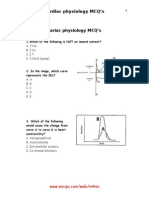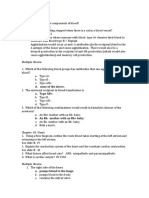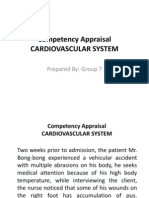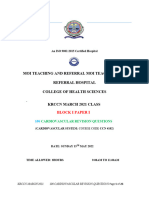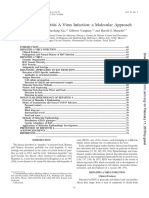Weekly Questions Week 2 4-8 MARCH 2012 Cardiovascular System
Weekly Questions Week 2 4-8 MARCH 2012 Cardiovascular System
Uploaded by
I'zzat AndikaCopyright:
Available Formats
Weekly Questions Week 2 4-8 MARCH 2012 Cardiovascular System
Weekly Questions Week 2 4-8 MARCH 2012 Cardiovascular System
Uploaded by
I'zzat AndikaOriginal Title
Copyright
Available Formats
Share this document
Did you find this document useful?
Is this content inappropriate?
Copyright:
Available Formats
Weekly Questions Week 2 4-8 MARCH 2012 Cardiovascular System
Weekly Questions Week 2 4-8 MARCH 2012 Cardiovascular System
Uploaded by
I'zzat AndikaCopyright:
Available Formats
WEEKLY QUESTIONS WEEK 2 4-8 MARCH 2012 CARDIOVASCULAR SYSTEM Histology of Blood Vessels 2 1.
Which of the following is FALSE regarding Weibel-Palade granules? I- It contains a protein known as Factor VII II- Present in veins III- Deficiency results in prolonged bleeding time IV- Its deficiency is among the causes of hemophilia A. B. C. D. 2. I and II III and IV I,II and III II,III and IV
Which of the following is responsible for peripheral resistance? A. Artery B. Arterioles C. Vein D. Venules
3. Which of the following is the TRUE statement about the tunica adventitia of portal vein? I- Thickest coat II- Consist of loose fibro-elastic connective tissue III- Smooth muscle has circular and transverse arrangement IV- Near their entry to heart, wall contain cardiac muscle A. I and II B. I and IV C. II,III and IV D. I,II and III 4. Which of the following layer will form valve of veins? A. Tunica intima B. Tunica media C. Tunica adventitia 5. Which of the following is TRUE statement regarding medium sized vein? A. Has thicker wall than medium sized artery B. Has narrow lumen usually circular in section C. Has well develop internal and external elastic lamina D. Has more vasa vasora
QMU WEEK 2 CVS 12
Blood supply of the heart 6. All of following are the correct answer regarding the common carotid artery EXCEPT: A. It ascend within the carotid sheath with internal jugular vein, internal carotid artery andthe last four cranial nerves B. It ends by giving two terminal branches, external and internal carotid artery C. The right common carotid arises from the superior cephalic artery D. Left common carotid artery arises from the arch of aorta 7. Choose the correct branches of external carotid artery I- Common facial artery II- Lingual artery III- Ascending pharyngeal artery IV- Occipital artery A. I & II B. II & III C. II, III & IV D. All of the above 8. Choose the correct answer regarding external carotid artery: A. Superficial thyroid artery is the termination of external carotid artery at the level of superior border of thyroid cartilage B. Occipital artery supply the scalp after piercing the trapezius muscle C. Maxillary artery wind around the lower border of mandible to reach the face D. Ascending pharyngeal artery ascend along the wall of larynx to supply it 9. All of the following are CORRECT regarding the internal carotid artery EXCEPT: A. It ascend horizontally in the neck B. It enters carotid canal in the base of the skull C. It reach foramen lacerum D. Curves up to enter floor of cavernous sinus 10. All are related to surface anatomy of the arteries supplying the head and neck, EXCEPT: A. The external carotid artery can be found at the midpoint between mastoid process and angle of mandible B. At superior border of thyroid cartilage, the external carotid artery begins C. Opposite to the neck of mandible, ext. Carotid artery end as two terminal branches D. Superficial temporal artery can be felt behind the auricle Cardiac Cycle I Answer TRUE or FALSE 11. Cardiac cycle is the phases of contraction and relaxation through associated changes of pressure and volume in different chambers and great vessel also by closure of valves 12. Systole of all heart take place in 0.3 seconds
QMU WEEK 2 CVS 12
13. Increasing heart rate affect more the diastolic time and may never affect cardiac performance 14. Choose the right statements below regarding the whole cardiac cycle I . Ventricular systole consist of isovolumetric contraction and ventricular ejection II. The stages of closure of all valves are during ventricular ejection and rapid ventricular filling III. The ventricular pressure during both isometric relaxation and contraction are constant IV. 75% ventricular filling is done by passive flow, through pressure gradient A B C D I , II, III II, III, IV I , III, IV All of the above
Match the stages with it duration of action correctly 15. 16. 17. 18. Atrial systole Ventricular systole Diastole of all heart Complete one beat A 0.3 seconds B 0.1 seconds C 0.4 seconds D 0.8 seconds
Cardiac Cycle II 19. The following statements are true regarding P wave except: A. Produced by the spread of depolarization wave from SA node to AV node B. Wave spreads from right to left therefore it is a positive wave C. It represents atrial depolarization and starts 0.02 seconds before atrial contraction D. Its duration is 0.2 sec and its amplitude is 0.1-0.0.3 mV 20. Choose the false statement regarding the QRS complex: A. Produced by ventricular depolarization B. Q wave is produced by depolarization of inter-ventricular septum C. R wave is produced by depolarization of the last segment of myocardium D. Its duration is 0.04-0.12 sec and its amplitude is 1-2 mV 21. Which is the correct statement about the abnormalities of QRS complex? A. Q wave is present but smaller in amplitude in ventricular septal defects B. Pathological deep Q wave appears in myocardial ischemia C. Duration of QRS complex is more than 0.12 sec in bundle branch block D. Amplitude of QRS complex decreases in ventricular hypertrophy 22. T wave is described as the following except: A. Due to the faster and stronger stage of ventricular depolarization B. The mean direction of depolarization wave in the ventricles is opposite to depolarization wave C. Its duration is 0.25 sec and its amplitude is 0.2-0.3 mV D. T wave is flattened in old age and inverted in myocardial infarction
QMU WEEK 2 CVS 12
23. All the following are true regarding P-R interval except: A. It is the time between the start of P wave to the start of R wave B. Its duration exceeding 0.2 sec indicates the second degree heart block C. Its normal duration is in 0.12-0.2 sec D. Represents atrial depolarization and conduction through AV node and bundle HISTOLOGY OF PERIPHERAL CIRCULATION 24. Which of the following regarding capillaries sites is WRONG? A. Kidney B. Lung C. Skin D. Muscles E. Nerves 25. All the following fenestrated capillaries has their pores covered by a thin diaphragm EXCEPT A. Pancreas B. Kidney C. Intestine 26. Choose the correct sites for sinusoids. I- Bone marrow II- Liver III- Spleen IV- Certain endocrine glands V- Renal glomeruli VI- Skin A. I, II, III, IV B. I, III, IV, V C. II, III, IV, V, VI D. I, III, IV, V 27. Choose the correct sites for A-V shunts I- Palm II- Sole III- Thyroid gland IV- Bone marrow V- Lip VI- Nose VII- Spleen A. I, II, III, IV, V B. II, III, V, VI, VII C. I, II, III, V, VI D. III, IV, V, VI, VII E. I, III, IV, V
QMU WEEK 2 CVS 12
28. What is the difference between sinusoid and lymph capillaries? A. Having wide lumen B. Irregular in shape C. Lack of continuous basal lamina D. Having anchoring filaments to the surrounding collagen Anti Arrythmic drug 29.
The phase 0 in the diagram equal to? A. B. C. D. P-R interval QRS complex R-T interval S-T interval
30. Which blocker that prolong action potential duration of cardiac muscle(refraction period)? A. B. C. D. Ca channel blocker Beta blocker Alpha blocker K+ channel blocker
31. Which of the following blocker that increase the P-R interval? A. B. C. D. Ca channel blocker Na channel blocker Alpha blocker K+ channel blocker
32. Which of the following blocker that slowing the conduction action potential of cardiac muscle? A. Ca channel blocker B. Na channel blocker C. Alpha blocker D. K+ channel blocker 33. Which of the following drugs that can produce Rythm Control? A. Beta and Ca channel blocker B. Alpha and Beta blocker C. Alpha blocker D. Na and K+ channel blocker
QMU WEEK 2 CVS 12
Cardiovascular regulatory mechanism 34. All of the following are TRUE about vasomotor neurons EXCEPT A. Vasomotor tone occurs resulting from active vasoconstriction neurons during rest B. Stimulation of vasodilator neurons directly produce generalized vasodilation C. Vasoconstrictor fibers from medulla excite vasoconstrictor neurons of sympathetic nervous system leading to increases in arterial blood pressure a pressor effect D. Stimulation of vasoconstrictor neuron produces positive chronotropic, inotropic, and dromotropic effect E. Medullary sensory area project output signal to these neurons to adjust their activity according to the situation 35. Which of the following are regarding cardioinhibitory neurons? I. II. III. IV. Control the parasympathetic activity of the heart Preganglionic fibers of the vagus relay in terminal ganglia at right atrium The vagi dilate the coronary vessels The vagi continuously transmitting inhibitory impulses to decrease high rhythm of the S-A node at any level of arterial blood pressure V. Vagus tone is reflexly produced through the baroreceptor I, II and III I, II and V I, IV and V All of the above
A. B. C. D.
36. All of the following are FALSE about innervations of the heart EXCEPT A. Inhibitory vagal tone dominates over the +ve chronotropic sympathetic tone B. Sympathetic tonic discharge to the heart during activity increase the pumping capacity of the heart by 20% C. The sympathetic supply controlled by vasomotor neurons D. Heart rate is directly proportional to the metabolic rate 37. Physiological variation of heart rate according to I. II. III. IV. A. B. C. D. Athletes have lower heart rate due to high vagal tone Circadian rhythm of heart rate is lowest in early morning and highest in evening Heart rate slows down to 60 bpm during quite rest Heart rate increases during standing by up to 35% I and III II and IV I, II and III I, II, III and IV
QMU WEEK 2 CVS 12
38. Choose the incorrect pair concerning relationship between age and heart rate A. B. C. D. Feotus 140-150 bpm Newborn 130-140 bpm 1-3 years 120-130 bpm Over 15 years- 70-80 bpm
Regulation of Myocardial Metabolism 39. The energy in the heart is mainly used in: A. B. C. D. Contraction Relaxation Both contraction and relaxation None of the above
40. Which of the following used by the healthy heart (well-perfused human heart) to generate energy? I. II. III. IV. Carbohydrate Lactate Fatty acid Protein
A, I, II and III B. I, III and IV C. II, III and IV D. I, II, III and IV 41. Lipolysis (breakdown of triglyceride) is regulated by the following hormone(s): A. B. C. D. Insulin Noradrenaline Adrenaline All of the above
42. The following events/hormones increase the membrane capacitance for glucose transport EXCEPT: A. B. C. D. Ischaemia Catecholamines Insulin Increase work demand
43. Important factors for transporting glucose into the cell are: I. II. III. IV. A. B. C. D. Carnitine shuttle system Presence of glucose transporter Glucose gradient Presence of adrenaline I and II II and III II and IV III and IV
QMU WEEK 2 CVS 12
44. Randle et al (Randle cycle) states that high rates of fatty acid oxidation inhibit the uptake and oxidation of glucose and lactate by the heart. At which pathway does the inhibition occurs? A. B. C. D. Phosphorylation of glycose by hexokinase B-oxidation of acyl-CoA to Acetyl-CoA Pyruvate decarboxylation to Acetyl-CoA Entry of pyruvate into mitochondria
45. Which of the following stimulate the inhibition of pyruvate dehydrogenase? I. II. III. IV. A. B. C. D. NADH ATP Acetyl-CoA Pyruvate I, II and III I, II and IV I, III and IV II, III and IV
CARDIAC REGULATORY MECHANISM 2 46. Which of the following statement is false about heart rate? A. The normal heart rate for adult male is about 75 beats per minute B. Heart rate generally refers to the atrial rate of beating and not the ventricle C. Heart rate lower than 60 beat per minute is called bradycardia while heart rate higher than 90 beat per minute is called tachycardia D. The heart rate of female is slightly higher than male due to lower blood pressure and lower vagal tone 47. The heart rate of a person may vary according to A. B. C. D. Metabolic rate Respiration Time of the day All of the above
48. Which of the following is false about the physiological variation of heart rate? A. Under basal condition with complete physical and mental rest, or during quiet sleep, the heart rate slows down to 60 beats per minute B. Athletes have lower heart rate than non-athletes at rest due to high vagal tone C. The heart rate increases during standing by up to 35 per cent of its basal value D. Male has lower heart rate than female during rest
QMU WEEK 2 CVS 12
49. Which of the following heart rate is not matched correctly with its corresponding age? A. B. C. D. Foetus 140-150 beats per minute Newborn 130-140 beats per minute From 1-3 years 100-120 Over 15 years 70-80
50. What is the factor that affects the cardiovascular centre? A. B. C. D. Changes in blood temperature Impulses from higher centre Changes in the chemical composition of blood All of the above
HAEMODYNAMICS CHANGES 51. Which of the following statement is FALSE regarding hyperemia & congestion. A. Hyperemia occurs when arterial and arteriolar dilatation produces the effects that open inactive capillaries. B. Congestion is due to impaired venous drainage C. Hyperemia is always pathological whereas congestion can be also due to physiological D. Grossly, hyperemia appear red while congestion appear much darker 52. Choose the correct statements regarding localized and systemic congestion. I. Localized venous congestion is due to impaired venous outflow from an organ while the systemic congestion is due to affection of central organ II. The effects of the acute localized congestion depend on the condition of the collateral. III. Dilatation of vessels proximal to the obstruction is the effects of the chronic local congestion IV. Mitral stenosis is one of the cause of acute generalized venous congestion A. B. C. D. I,II II,III I,III,IV I,II,III
53. Which of the following is NOT the general effects of venous congestion? A. B. C. D. Hypoxia Fibrosis Cyanosis Edema
QMU WEEK 2 CVS 12
54. Which of the following is False regarding chronic venous congestion at the lungs? A. B. C. D. It is due to increase in the pressure at the left atrium Its cut surface is mottled and alternate with dark red areas At late stage it appears brown,firm and indurated. Macrophage in this case is known as heart failure cell
55. Choose the CORRECT statements regarding chronic venous congestion of the liver A. B. C. D. It is cause by the right-sided heart failure At late stage,it will increase in size due to cardiac cirrhosis Central vein and the sinusoid is distended with blood The tissues located nearest to the central region undergo atrophic
56. All the followings are higher centers involved in heart rate regulation EXCEPT: A. B. C. D. Cerebral cortex Thalamus and limbic system Respiratory center Hypothalamus
57. What is Bainbridge reflex? A. During increase in arterial pressure, it will increase the heart rate and strength of contraction B. Excitation of baroreceptors by increasing the pressure in arteries reflexly causes the arterial pressure to decrease C. Increase of atrial heart pressure reflexly will increase heart rate. D. None of above 58. One degree centigrade rise in body temperature increases the heart rate by about : A. B. C. D. 10 beats/min 15 beats/hour 10 beats/hour 15 beats/min
59. How mechanism of thyroxine hormone increase heart rate? I. II. III. IV. A. B. C. D. Directly stimulating SA node Increase metabolic rate of the body Direct stimulating AV node Stimulating effect on sympathetic system I AND II II, III AND IV I, II AND IV I, II ,III AND IV
QMU WEEK 2 CVS 12
60. Which are the following is TRUE statement : A. B. C. D. Hypoxia increases herat rate * Severe emotions lead to reflex increased in heart rate Chemoreceptors are sensitive to pressure Carbon dioxide excess in moderate amounts decrease the heart rate
Physiological properties of heart 2 61. All of the following are true about myocardial rhythmicity EXCEPT A. Is myogenic in nature B. Is the ability of the cardiac muscle to generate action potential spontaneously and regularly C. Ectopic pacemaker possesses the greatest rhythmicity and initiate beat of the whole heart D. A-V nodal rhythm produce slower heart rate 62. Choose the incorrect pair A. B. C. D. S-A node - 105 beats /minute A-V node - 45-60 beats /minute Purkinje system - 25-40 beats/minute Idioventricular rhythm - 30-50 beats/minute
63. Which of the following false regarding the factors affecting myocardial rhythmicity ? I. Whole heart is innervated by vagus nerve and sympathetic nervous system except ventricle II. S-A node discharges at a rate about 105 impulse/minute intrinsic heart rate III. Myocardial rhythmicity increase with increase in body temperature IV. Excess of calcium can increase the diastole until the heart stops in diastole A. I and II B. II and III C. III and IV D. I, II and IV 64. All of the following incorrect about conductivity of the heart EXCEPT A. Physiologically, A-V node has very long relative refractory period B. A-V node protect the ventricle from pathological hyperkinesis of atria C. Rapid impulse conduction through purkinjes fiber because this fiber has many fascia adherens and gap junction D. A-V node is medium in size and its intercalated disc contain less gap junction
QMU WEEK 2 CVS 12
65.
S-A node A-V node purkinjes fiber
bundle of His
bundle branches
terminal
Which of the following physiological properties of the heart describe the table above A. B. C. D. Rhythmicity Conductivity Excitability Contractility
Antiarrythmic Drug II 66. The following are true EXCEPT A. B. C. D. Flecainide can be given to patients with myocardial infarction All anti-dysrrhythmic drugs prolong QRS complex duration Lidocaine can be given to patients with heart failure Quinidine can be used in treatment of supraventricular dysrrhythmia
67. The following statements are true EXCEPT A. B. C. D. Class Ia and Ib prolong QT interval Torsade de pointes is not seen in calcium channel blocker drugs Lidocaine depresses nervous system Depression of cardiac contractility is most significant in Ic administration
68. Choose the correct statements I. Flecainide is used in both treatment of ventricular and supraventricular tachyarrhythmias II. Non lethal reentrant ventricular tachyarrhythmias is induced by flecainide III. Beta blockers can be used against arrhythmia in patient with myocardial infarction IV. Torsade de pointes rarely occur in administration of amiodarone due to its ability to block Na+ channel A. I & II B. II & III C. I & III D. III & IV
QMU WEEK 2 CVS 12
69. Choose the correct statements I. II. III. IV. A. B. C. D. Extracardiac adverse effects of lidocaine can cause death All class I drugs are associated with proarrhythmia with the least significant being Ib Verapamil is used in the acute management of paroxysmal atrial tachycardia Verapamil can cause death if used in patients with ventricular tachycardias I & II II & III III & IV II, III & IV
70. The following are false EXCEPT A. Class II, III, IV and V antiarrhythmic drugs act by decreasing AV conduction B. Flecainide prolongs action potential duration C. Lidocaine must be given IV to have effects on the heart due to its minimal absorption in the GIT if given orally D. The safest antiarrhythmic drugs are class IV drugs ANSWERS: 1 2 3 4 5 6 7 8 9 10 A 69 B 68 B 69 A 70 D 70 C 26 11 12 13 14 15 16 T F F C B A C D 21 22 23 24 25 26 27 28 C 97 31 D 97 B 98 A 72 B 73 A 74 C 74 D 76 B D 32 33 34 35 36 37 38 39 40 A B D B 106 B 105 A 106 C 107 C 107 C A 41 42 43 44 45 46 47 48 49 50 D B B C A B 107 D 107 C 107 C 107 D 108 51 52 53 54 55 56 57 58 59 60 C D B B B B C D C A 61 62 63 64 65 66 67 68 69 70 C B7 D 87 D 87 B 89 B 89 A A C D A
C 27 17 B 27 A 28 D 27 18 19 20
D 29 96 C 97 30
YOUTH IS THE MOST PRECIOUS TIME OF YOUR LIFE, BE SURE TO MAKE THE BEST OUT OF IT! ALL THE BEST!!
QMU WEEK 2 CVS 12
You might also like
- Ecg Post TestDocument9 pagesEcg Post TestLala SantiNo ratings yet
- TB-Chapter 20 Heart and Neck Vessels PDFDocument19 pagesTB-Chapter 20 Heart and Neck Vessels PDFShawya Assadi67% (3)
- Pathophysiology of Nontoxic Nodular GoiterDocument2 pagesPathophysiology of Nontoxic Nodular GoiterKaila Abeleda100% (3)
- Cardiac Physiology MCQsDocument13 pagesCardiac Physiology MCQsالعراقي الصامد100% (3)
- The Red QueenDocument2 pagesThe Red QueenDoris Georgia100% (1)
- Chapter 17 INTERPRETING ELECROCARDIOGRAMDocument7 pagesChapter 17 INTERPRETING ELECROCARDIOGRAMZahra Margrette SchuckNo ratings yet
- Anatomy MC Question CH 17-22Document4 pagesAnatomy MC Question CH 17-22lmaoheartsNo ratings yet
- Biochem ABO IncompatibilityDocument62 pagesBiochem ABO IncompatibilityChi Samaniego100% (4)
- TERM 2 Chapter 8 Topical RevisionDocument74 pagesTERM 2 Chapter 8 Topical RevisionElil MathhyNo ratings yet
- 5 - Cardio Batch 2016 AnsweredDocument8 pages5 - Cardio Batch 2016 AnsweredCaroline AgathaNo ratings yet
- AA CVS Questions FinalDocument21 pagesAA CVS Questions FinalMahmoud hilmyNo ratings yet
- TEAMS - MCQsDocument34 pagesTEAMS - MCQsLyness Kay CheushiNo ratings yet
- Cardiovascular DrillsDocument12 pagesCardiovascular DrillsMaria Garcia Pimentel Vanguardia IINo ratings yet
- Cardio 2015 + AnswerDocument18 pagesCardio 2015 + Answerstella pangestikaNo ratings yet
- y1 2024 Met Cvs Um2, Umm, UmtgiDocument23 pagesy1 2024 Met Cvs Um2, Umm, UmtgiYoon Pan YatiNo ratings yet
- Physiology of Cardiovascular SystemDocument8 pagesPhysiology of Cardiovascular Systemvmwanza151No ratings yet
- Prepared By: Group 7Document41 pagesPrepared By: Group 7Ehm Zhy NhelNo ratings yet
- KRCCN NCK CVS Revision Paper Mar 2021Document26 pagesKRCCN NCK CVS Revision Paper Mar 2021Leonard Oduor OtienoNo ratings yet
- PAPER C Kmu 2023 (Completely Solved)Document17 pagesPAPER C Kmu 2023 (Completely Solved)aadiikhan27388No ratings yet
- Med Surge 1Document39 pagesMed Surge 1rave andrei MacanayaNo ratings yet
- Chapter 5 - QuestionsDocument3 pagesChapter 5 - QuestionsSue Jie ChewNo ratings yet
- A&P II Assignment 3Document5 pagesA&P II Assignment 3hepnandeNo ratings yet
- Cardio Exam 2Document11 pagesCardio Exam 2Makkah MohammedNo ratings yet
- CardioDocument6 pagesCardioShrutiNo ratings yet
- 23Document11 pages23monicaNo ratings yet
- Ecg MCQSDocument2 pagesEcg MCQSZafar Iqbal Manj100% (2)
- Cardiovascular NCLEX QuestionsDocument12 pagesCardiovascular NCLEX QuestionsAivan Karl AmbaganNo ratings yet
- CardioDocument10 pagesCardioSaja SaqerNo ratings yet
- CCN Prelim Quiz 1Document3 pagesCCN Prelim Quiz 1Angela Ruth EstradaNo ratings yet
- RCP 200 CH 17Document10 pagesRCP 200 CH 17xzlokainNo ratings yet
- Lab Test (8+9) 2023Document2 pagesLab Test (8+9) 2023vaughanc1117No ratings yet
- Cardiovascular Disease QuestionsDocument10 pagesCardiovascular Disease QuestionsRodesa MigarNo ratings yet
- Cardio Nclex Practice ExamDocument27 pagesCardio Nclex Practice ExamAliza Abn bklNo ratings yet
- The "A" Wave of The Atrial Pressure Curve Is Due To: A. Distension of The Atria Due To Blood Accumulation During Ventricular Systole B. S.A Node Contraction C. Contraction of The AtriumDocument8 pagesThe "A" Wave of The Atrial Pressure Curve Is Due To: A. Distension of The Atria Due To Blood Accumulation During Ventricular Systole B. S.A Node Contraction C. Contraction of The AtriumQairul AzmanNo ratings yet
- Paper C 2019 With Key andDocument28 pagesPaper C 2019 With Key andaizaz100% (1)
- Blood Pressure - QuestionsDocument5 pagesBlood Pressure - QuestionsErjus Hoxhaj100% (1)
- Cardio CompilationDocument13 pagesCardio CompilationSyed Talha Bin AqeelNo ratings yet
- Cardiac surgery 5th year 2017-محلولDocument11 pagesCardiac surgery 5th year 2017-محلولIbrahim Barham50% (2)
- 4 - ADocument39 pages4 - AFarnoush ShahriariNo ratings yet
- AC78 CVS IDocument18 pagesAC78 CVS Iguita2808No ratings yet
- Heart Circulatory System Study GuideDocument10 pagesHeart Circulatory System Study GuideKyle YiNo ratings yet
- NP 1 5 Thank Me LaterDocument36 pagesNP 1 5 Thank Me Laterlhie cabanlitNo ratings yet
- Normal Physiology Final Exam 100Document14 pagesNormal Physiology Final Exam 100harshamanikandan05No ratings yet
- Question Week 5Document9 pagesQuestion Week 5I'zzat AndikaNo ratings yet
- Past Year Cvs 1Document10 pagesPast Year Cvs 1Suhana BasheerNo ratings yet
- Cvs and Circulation Ahs First Year RemedialDocument7 pagesCvs and Circulation Ahs First Year RemedialMinahil MaqboolNo ratings yet
- (Answers)Bank CVSDocument24 pages(Answers)Bank CVSMariam GamalNo ratings yet
- Mcqcvsnursing 1 231228233827 4ada3c13Document27 pagesMcqcvsnursing 1 231228233827 4ada3c13haederalsarey4No ratings yet
- BlankDocument26 pagesBlankTrupti ViraNo ratings yet
- 2015+ AnsDocument18 pages2015+ AnsPavitra RamasamyNo ratings yet
- Post Test Cardiac MSDocument34 pagesPost Test Cardiac MSEköw Santiago JavierNo ratings yet
- MCQ Blok 10 2007Document11 pagesMCQ Blok 10 2007Gebina Wahyu ArdinaNo ratings yet
- 2 Shifting Test Bank Physio: Quiz #7 Electrical Activity of The Heart and ECGDocument11 pages2 Shifting Test Bank Physio: Quiz #7 Electrical Activity of The Heart and ECGAl SyNo ratings yet
- Neet Iv-Test Body Fluids and CirculationDocument8 pagesNeet Iv-Test Body Fluids and CirculationYash KapoorNo ratings yet
- Cardio MidtermDocument8 pagesCardio MidtermCharlz ZipaganNo ratings yet
- The HeartDocument15 pagesThe HeartCLEMENTNo ratings yet
- For Questions Number 1-5, Refer To Scenario BelowDocument48 pagesFor Questions Number 1-5, Refer To Scenario BelowPuravin Crishan VeerasamyNo ratings yet
- National College For Medical and Technical Studies: Cardiovascular SystemDocument7 pagesNational College For Medical and Technical Studies: Cardiovascular Systemsajahamad208No ratings yet
- امسكيو الكارديوDocument26 pagesامسكيو الكارديوaliirajaa13No ratings yet
- Week 1 in Video Quizzes PDFDocument10 pagesWeek 1 in Video Quizzes PDFIsthafa AlanisaNo ratings yet
- Self-Assessment: BOFs for MRCP(UK) and MRCP(I) Part IFrom EverandSelf-Assessment: BOFs for MRCP(UK) and MRCP(I) Part INo ratings yet
- MCQs in Cardiothoracic Surgery Mansoura Comprehensive Review with ExplanationsFrom EverandMCQs in Cardiothoracic Surgery Mansoura Comprehensive Review with ExplanationsNo ratings yet
- Qmu Week 5 RespiDocument12 pagesQmu Week 5 RespiI'zzat AndikaNo ratings yet
- Module 11 Week 1Document11 pagesModule 11 Week 1I'zzat AndikaNo ratings yet
- Module 11 Week 3Document10 pagesModule 11 Week 3I'zzat AndikaNo ratings yet
- Soalan 6th WeekDocument13 pagesSoalan 6th WeekQairul AzmanNo ratings yet
- فالاتلين تونسيلDocument3 pagesفالاتلين تونسيلI'zzat AndikaNo ratings yet
- Question Week 5Document9 pagesQuestion Week 5I'zzat AndikaNo ratings yet
- Practical PharmacoDocument3 pagesPractical PharmacoI'zzat AndikaNo ratings yet
- Nerve Injuries Nerve Deformity Causes Motor Loss / Paralysis Sensory Loss Erb's Palsy (Erb-Duchenne)Document3 pagesNerve Injuries Nerve Deformity Causes Motor Loss / Paralysis Sensory Loss Erb's Palsy (Erb-Duchenne)I'zzat AndikaNo ratings yet
- Growth Status Among Females of Solan District of Himachal PradeshDocument9 pagesGrowth Status Among Females of Solan District of Himachal PradeshDr. Krishna N. SharmaNo ratings yet
- Delta Green - Autopsy of A ByakheeDocument4 pagesDelta Green - Autopsy of A ByakheeLuca LiperiNo ratings yet
- Lymphoproliferative Disorders: Chronic Lymphocytic Leukemia-CLL Hairy Cell Leukemia Plasma Cell DisordersDocument42 pagesLymphoproliferative Disorders: Chronic Lymphocytic Leukemia-CLL Hairy Cell Leukemia Plasma Cell DisordersyosefNo ratings yet
- Breastfeeding - CompiledDocument81 pagesBreastfeeding - CompiledMuvenn KannanNo ratings yet
- T4 Reactiv ChemiluminiscentaDocument5 pagesT4 Reactiv ChemiluminiscentaLidia NarbNo ratings yet
- The Noosphere Art Wave Project - Complete Project DescriptionDocument34 pagesThe Noosphere Art Wave Project - Complete Project DescriptionBoris PetrovicNo ratings yet
- Soal Hots Bhs InggrisDocument2 pagesSoal Hots Bhs Inggrisdea ayu puspitaNo ratings yet
- Strain ImprovementDocument32 pagesStrain ImprovementArya mpNo ratings yet
- ADD-00003887 IA Traceability Uncertainty Measurement-EnDocument9 pagesADD-00003887 IA Traceability Uncertainty Measurement-EnAnonymous dC6sUCNo ratings yet
- CMSE Question PapersDocument285 pagesCMSE Question PapersHari WaranNo ratings yet
- Cambridge International AS & A Level: Biology 9700/23 May/June 2020Document15 pagesCambridge International AS & A Level: Biology 9700/23 May/June 2020Mohamed HNo ratings yet
- Fri 1 - AML MDS Updates - LoghaviDocument45 pagesFri 1 - AML MDS Updates - Loghavisnap kingNo ratings yet
- Sudden Infant Death Syndrome: IncidenceDocument6 pagesSudden Infant Death Syndrome: IncidenceSirish ShresthaNo ratings yet
- Nutritional Requirements Presentation DR SinghDocument55 pagesNutritional Requirements Presentation DR SinghSharad MohipNo ratings yet
- Endometrial CancerDocument34 pagesEndometrial CancertyasdwiarumNo ratings yet
- Karyotyping Lesson Plan - Biology 30sDocument3 pagesKaryotyping Lesson Plan - Biology 30sapi-395453264No ratings yet
- Skeletal Muscle Development and Regeneration: Concise ReviewDocument12 pagesSkeletal Muscle Development and Regeneration: Concise Reviewtesfaye mekonnenNo ratings yet
- Result: Uncertain: Next StepsDocument8 pagesResult: Uncertain: Next StepsOana AndreefNo ratings yet
- Determination of ParasitemiaDocument4 pagesDetermination of ParasitemiaDoctorKawaiiNo ratings yet
- Red Blood Cell MorphologyDocument5 pagesRed Blood Cell MorphologyRyan KadavilNo ratings yet
- Community Nutrition Instructional DesignDocument5 pagesCommunity Nutrition Instructional DesignChristine HernandezNo ratings yet
- 4 M Ncov Insert L28mcov1enr0 en 20200228Document2 pages4 M Ncov Insert L28mcov1enr0 en 20200228SantiagoAFNo ratings yet
- 0610 s12 Ms 32 PDFDocument10 pages0610 s12 Ms 32 PDFNyantuy. MieNo ratings yet
- Gastrointestinal Tract and Digestion in The Young Ruminant: Ontogenesis, Adaptations, Consequences and ManipulationsDocument10 pagesGastrointestinal Tract and Digestion in The Young Ruminant: Ontogenesis, Adaptations, Consequences and ManipulationsSusila Semadi PutraNo ratings yet
- Paper I: Biochemistry and Analytical Techniques: B.Sc. I Year (Biotechnology) Semester I MM: 85 Session 2011-12Document14 pagesPaper I: Biochemistry and Analytical Techniques: B.Sc. I Year (Biotechnology) Semester I MM: 85 Session 2011-12Rupa SreejaNo ratings yet
- Diagnosis of Hepatitis A Virus Infection: A Molecular ApproachDocument17 pagesDiagnosis of Hepatitis A Virus Infection: A Molecular ApproachrehanaNo ratings yet
- 5 6143112794578354306Document4 pages5 6143112794578354306rizky setiawanNo ratings yet



